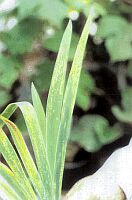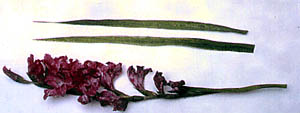Virus diseases of gladiolus
More than 7 virus diseases have been recorded in gladiolus, and of these bean yellow mosaic virus (BYMV) and cucumber mosaic virus (CMV) are the most economically important and widespread in Australia.
Symptoms of BYMV and CMV
Gladiolus plants infected with BYMV and CMV often have pale-yellow mottling of the leaves, (Figure 1).

Symptoms also include 'flower break' (Figure 2) and 'colour break' of flowers, but not in white, cream or yellow cultivars. BYMV can reduce the production of gladiolus corms by about 33 per cent.

Infected plants may have a shortened life span and corms are also more susceptible to fungal attack.
Spread and source of infection
The most common source of infection in gladiolus is from existing gladiolus crops that are infected with the viruses. Both viruses are spread from plant to plant by aphids which transmit these viruses in only 30 seconds. Aphids will also feed on corms so this means gladiolus are susceptible to virus spread during storage.
Host range
Both viruses are able to infect a wide range of different plant species, including many common weeds, pasture legumes, other bulb species, and vegetables.
Controlling viruses
Viruses cannot be treated or cured. The best control strategy is to plant corms from virus tested stock.
To minimise the risk of infecting healthy stock:
- use suitable insecticides for the control of aphids on both the cultivated crop and the stored gladiolus corms
- rogue any plants which show symptoms and destroy this material
- plant virus-tested gladiolus material at least 1 km (if possible) from virus-infected gladiolus crops.
Reporting an unusual plant insect pest or disease
Report any unusual plant pest or disease immediately using our online reporting form or by calling the Exotic Plant Pest Hotline on 1800 084 881. Early reporting increases the chance of effective control and eradication.
Please take multiple good quality photos of the pests or damage to include in your report where possible, as this is essential for rapid pest and disease diagnosis and response.
Your report will be responded to by an experienced staff member, who may seek more information about the detection and explain next steps.
Report online